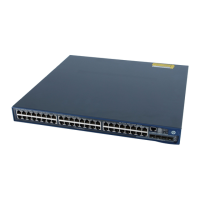193
Because the SA message is from an MSDP peer—RP 2—in the same AS, and the MSDP peer is the
next hop on the optimal path to the source-side RP, RP 3 accepts the message and forwards it to
other peers—RP 4 and RP 5.
3. When RP 4 and RP 5 receive the SA message from RP 3:
Because the SA message is from an MSDP peer—RP 3—in the same mesh group, RP 4 and RP 5
both accept the SA message, but they do not forward the message to other members in the mesh
group. Instead, they forward it to other MSDP peers—RP 6 in this example—out of the mesh group.
4. When RP 6 receives the SA messages from RP 4 and RP 5—suppose RP 5 has a higher IP address:
Although RP 4 and RP 5 are in the same AS—AS 3—and both are MSDP peers of RP 6, because
RP 5 has a higher IP address, RP 6 accepts only the SA message from RP 5.
5. When RP 7 receives the SA message from RP 6:
Because the SA message is from a static RPF peer—RP 6, RP 7 accepts the SA message and
forwards it to other peer—RP 8.
6. When RP 8 receives the SA message from RP 7:
A BGP or MBGP route exists between two MSDP peers in different ASs. Because the SA message is
from an MSDP peer—RP 7—in a different AS, and the MSDP peer is the next hop on the BGP or
MBGP route to the source-side RP, RP 8 accepts the message and forwards it to its other peer—RP
9.
7. When RP 9 receives the SA message from RP 8:
Because RP 9 has only one MSDP peer, RP 9 accepts the SA message.
SA messages from paths other than those described previously are not accepted or forwarded by MSDP
peers.
Implementing intra-domain Anycast RP by leveraging MSDP peers
Anycast RP refers to an application that enables load balancing and redundancy backup between two
or more RPs within a PIM-SM domain by configuring the same IP address for, and establishing MSDP
peering relationships between, these RPs.
As shown in Figure 57, within a PIM-SM domain, a
multicast source sends multicast data to multicast
group G, and Receiver is a member of the multicast group. To implement Anycast RP, configure the
same IP address—known as “Anycast RP address”, typically a private address—on Router A and Router
B, configure these interfaces as C-RPs, and establish an MSDP peering relationship between Router A
and Router B.
NOTE:
Usually an Anycast RP address is configured on a logic interface, like a loopback interface.

